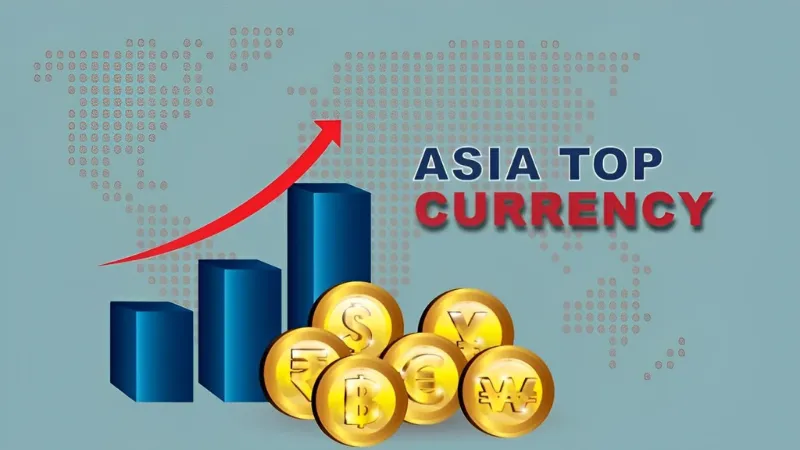
Currency exchange rates compare the value of one country’s currency to another. While the US dollar is the most widely traded and powerful currency, it’s not the strongest among all fiat currencies worldwide.
Asia, the fastest-growing and largest economy, is home to several countries with strong currencies. The continent is diverse, with a rich cultural heritage and some of the world’s oldest civilizations. Many Asian nations have robust economies that help support the strength and stability of their currencies. Among them, the strongest currency in Asia is the Kuwaiti Dinar (KWD), known for its high value against the US dollar.
In this article, we will explore the highest and strongest currencies in Asia. Here is a list of the top 10 Asian currencies compared to the US dollar.
Here is a list of the top 10 Asian currencies compared to the US dollar.
List Of Highest Currencies In The Asian In 2025
Table of Contents
list of Asian countries with the highest currency in 2025
Kuwaiti Dinar

Kuwaiti dinar (KWD) is the highest and strongest currency in the world As of June 2024. It is valued at 3.26 KWD per US dollar.
Kuwait is situated between Saudi Arabia and Iraq. The country uses its oil resources to maintain the value of its currency. The dinar has been in use since 1961. The dinar is now linked to an undisclosed basket of currencies but was initially pegged to the British pound.
Kuwait’s economy relies heavily on oil and gas exports. It is a leading member of OPEC and has one of the highest standards of living, which is supported by a generous welfare system. Overall, the strength of the Kuwaiti dinar reflects the country’s economic stability, as The Kuwaiti dinar (KWD) is the most expensive currency in Asia.
Bahraini Dinar

Bahraini dinar (BHD) is the second most valuable currency in the world. It has an exchange rate of 2.65 BHD per USD.
Bahrain is an island nation located between Qatar and Saudi Arabia. Its main exports include petroleum products, raw aluminum, and iron ore. Bahraini dinar was introduced in 1965. Bahrain’s economy relies heavily on oil and gas. It has diversified into finance, tourism, commerce and manufacturing. The country is a major banking hub known for its modern financial services.
Bahrain is famous for its impressive architecture, which includes the Bahrain World Trade Center and the National Theatre. The steady influx of tourists boosts the service sector and helps maintain the dinar’s value. Seventy percent of Bahrain’s government revenue comes from petroleum. One Bahraini dinar equals 223.09 Indian rupees, or INR 1 equals 0.004 BHD.
Omani Rial

Oman’s national currency, the Omani Rial (OMR), ranks third on the list of the highest currencies in the world. The OMR has a fixed exchange rate pegged to the US dollar. The exchange rate is pegged at 2.59, meaning $1 can buy 0.38 Omani Rial.
Oman is a coastal nation in Middle-east Asia bordered by Saudi Arabia, Yemen, and UAE. Oman’s economy is dependent on its oil exports. The Oman Rial was introduced in 1973. Oman focuses on oil and gas exports, which account for the majority of its government income.
The country also invests in other sectors, such as tourism, logistics and manufacturing. Oman is known for its magnificent natural landscapes, which include the Wahiba Sands Desert and the Hajar Mountains.
Jordanian Dinar

Jordanian official currency is the Jordanian dinar (JOD). It was introduced in 1949. It is the fourth strongest currency in Asia. The dinar is pegged to the US dollar. One US dollar is equal to 0.71 Jordanian dinars.
The country is landlocked and borders Egypt, Syria, Iraq and Saudi Arabia. Jordan’s economy relies on phosphate mining, agriculture, and tourism. The stability of the dinar comes from sound economic policies and fiscal discipline. Jordan is known for its rich history and UNESCO World Heritage Sites, including Petra’s ancient city. Jordan is less dependent on oil and gas exports, which is the reason behind the challenges of slow economic growth and rising debt.
Brunei Dollar

The official currency of Brunei is the Brunei dollar (BND). It has been in use since 1967. As of June 2024, one US dollar equals 1.35 Brunei dollars.
Brunei’s economy is mainly supported by oil and gas exports, making it one of Southeast Asia’s most stable. Brunei is a high-income nation and one of the world’s largest producers of liquefied natural gas.
Brunei’s currency remains stable due to the country’s abundant natural resources. Brunei is also a popular tourist destination with beautiful beaches and pristine rainforests. The Brunei dollar is often used interchangeably with the Singapore dollar, which reflects the strong relationship between the two countries.
Singapore Dollar

The Singapore dollar (SGD) is Singapore’s official currency. It was introduced in 1967. It is one of the most influential currencies in Southeast Asia. The SGD is one of the most traded currencies globally. It accounts for about 1.8% of daily forex trades. As of June 2024, one US dollar equals 1.35 Singapore dollars.
Since gaining independence from Malaysia, Singapore has grown significantly. Currently, Singapore is a high-income economy with a business-friendly environment that promotes economic growth. The country’s top exports include integrated circuits, refined petroleum, and gold.
The Monetary Authority of Singapore manages the Singapore dollar’s exchange rate. MAS operates SGD to prevent the high volatility of the currency.
Azerbaijani Manat

The Azerbaijani manat (AZN) is the official currency of Azerbaijan. It was introduced in 2006. It is among the top 10 currencies in Asia. Currently, one US dollar equals 1.70 Azerbaijani manats.
Azerbaijan shifted to an oil-based economy after the Soviet era, strengthening its economic position and boosting the manat’s value. Azerbaijan is also known for its rich cultural heritage and landscapes. Azerbaijan’s economy relies on exports of natural resources but has diversified into agriculture, tourism, and manufacturing. The petroleum industry helps maintain the stability of the manat through significant foreign currency inflows.
Turkmen Manat

The Turkmen manat (TMT) is the official currency of Turkmenistan. It was introduced in 1993 after the Soviet Union collapsed. Before the introduction of Turkmen manat, the country used Russian rubles. Currently, one US dollar equals 3.50 Turkmen manats.
The economy relies on oil and gas resources along with intensive agriculture. The Central Bank of Turkmenistan manages the currency of Turkmenistan. Turkmenistan has a growing economy and is known for its vast oil and gas resources. The country has also transformed its desert areas into productive agricultural regions, producing cotton and wheat.
Israeli Shekel

The Israeli shekel (ILS) is Israel’s official currency. It was introduced in 1986 as the new shekel. Currently, one US dollar equals 3.72 shekels. Israel is the 29th largest economy in the world, with a GDP of $525 billion in 2022.
The country’s currency remains strong despite regional tensions and is used in the occupied Palestinian territories. Israel exports diamonds, integrated circuits, refined petroleum, medical instruments, and potassic fertilizers, and its key markets are the United States, China, and the United Kingdom.
Saudi Riyal

The Saudi riyal (SAR) is the official currency of Saudi Arabia. It was introduced in 1925. Currently, one US dollar equals 3.75 Saudi riyals.
Saudi Arabia’s currency’s stability is supported by the country’s vast oil reserves, which are a major part of the global oil supply. Saudi Arabia has the largest economy in the MENA region. The country is known for its historical and religious significance as the birthplace of Islam.
Saudi Arabia is home to the holy cities of Mecca and Medina. The country is working to diversify its economy. It has relaxed regulations to promote international trade and tourism. The Saudi riyal is one of Asia’s strongest currencies.
Conclusion
As the world progresses, Asian countries keep up with the pace and move forward. While China and India are the biggest economies in Asia, their currencies, the Chinese Yuan and Indian Rupee, are not among the strongest in the region.
However, the strong currencies of other Asian countries reflect how well they manage their economies. Many nations that were once considered developing countries are now thriving, contributing to Asia’s overall growth. Known for its diverse cultures, rich heritage, and beautiful landscapes, Asia is now prospering in technology and economic strength. The strongest currency in Southeast Asia is the Brunei Dollar (BND), which holds a high value compared to many other regional currencies.
FAQs
What is the top 10 currency in Asia?
The Kuwaiti dinar (KWD) is the world’s strongest currency.
Which Asian country has the highest currency?
The Kuwaiti Dinar (KWD) is known as the highest currency in the world. It is widely used in the Middle East, especially for oil-related transactions.
Which country in Asia has the highest currency?
Kuwait, Bahrain, Oman, and Jordan are the Asian countries with the highest currencies.
Which country has the highest currency in Asia?
The Kuwaiti Dinar is known as the world’s highest currency.
Which Southeast Asian currency ranked top in 2025?
The Malaysian rupiah was the strongest currency in Southeast Asia in the third quarter of 2025.
Which Asian country has the highest currency value?
The Kuwaiti Dinar is the official currency of Kuwait and is currently the world’s strongest currency.
Which Asia country has the highest currency?
The country in Asia with the highest currency is Kuwait. The Kuwaiti Dinar (KWD) is the strongest currency in Asia and also one of the highest-valued currencies in the world when compared to the US dollar.




![Top 10 Currency in Asia [2024 List] Some Asian countries rank among the highest currencies in the world. Here is a list of top 10 Asian currencies compared to the US dollar.](https://startuprise.org/wp-content/uploads/2024/10/Top-7-696x392.webp)
